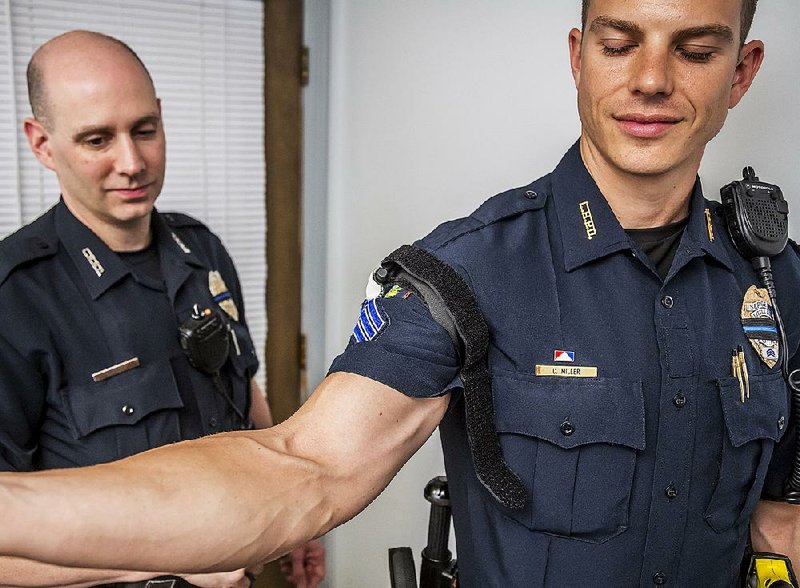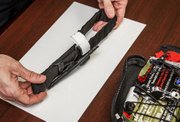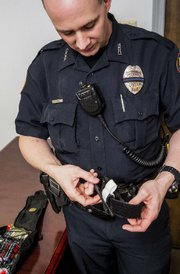The tourniquet was once headed the way of bloodletting, to the medical junkyard.
After World War II, the tourniquet -- around since the age of Alexander the Great -- was deemed more dangerous than useful in controlling bleeding, with the damage from stopped blood flow being more harmful than the loss of blood.
"When you use something a lot, the poor outcomes sort of come to the forefront, and I think people were not using them properly, with some bad outcomes, with tissue loss and ischemia," says Dr. Ronald D. Robertson, medical director of trauma at UAMS Medical Center.
It took the wars in Afghanistan and Iraq for the tourniquet to regain its life-saving status.
According to a National Academies of Science, Engineering and Medicine report released in June, before the March 2003 invasion of Iraq, the Department of Defense's Committee on Tactical Combat Casualty Care "called for every American deployed to war to carry and know how to use a modern tourniquet to treat battlefield casualties." The emphasis was on stopping bleeding faster because the U.S. Army considers hemorrhaging as the No. 1 preventable cause of death on the battlefield.
Still, tourniquets weren't issued to all troops nor were all troops trained in their use at first. After a series of congressional inquiries in 2005, field tourniquets were introduced across the military, the report states. The result? From 2005 to 2011, an estimated 1,000 to 2,000 lives were saved after tourniquets were issued to deploying U.S. military service members.
Those lessons learned on battlefields in foreign lands are now being applied at home.
Since 2001, approximately 2 million U.S. civilians have died from trauma (such as a motor vehicle crash, gun violence or fall, but not poisoning), including 147,790 in 2014, according to the National Academies report by a panel of medical experts, which calls for integrating military and civilian trauma systems.
The reports states that as many as 20 percent of those deaths in 2014 might have been prevented with optimal trauma care.
According to the U.S. Army Institute of Surgical Research, 30 percent to 40 percent of civilian deaths by traumatic injury are the result of hemorrhaging. Of those deaths, 33 percent to 56 percent occur before the patient reaches a hospital.
Re-enter the tourniquet, which is once again proving its usefulness at home, whether in active shooter situations, car wrecks, cuttings or attacks like the 2013 Boston Marathon bombing, where 27 tourniquets were applied at the scene.
Now many central Arkansas law enforcement members carry tourniquets.
POLICE FIRST
In 2014, Arkansas Trauma System and Little Rock's ambulance service, Metropolitan Emergency Medical Services, started an initiative to equip and train central Arkansas law enforcement members in the use of emergency medical kits, which contain what is known as a combat-application tourniquet along with gauze, bandages, gloves and chest seals.
"When seconds count, your ambulance is minutes away, and that's why we focused so hard on law enforcement initially," says Maj. Clayton Goddard, special operations supervisor for Metropolitan Emergency Medical Services of Little Rock.
"Whether it be an active shooter, active aggressor incident or just someone in a car wreck or whatever, in sheer numbers there are more law enforcement than there are your full-time paid fire or [medics], so we focused on law enforcement to put these kits in their hands."
More than 2,000 law enforcement officers in central Arkansas have been trained in the use of the kits and the tourniquets, Goddard says. The plan is to expand the training and kits to law enforcement throughout the state.
North Little Rock police were issued kits in 2014, and about 95 percent of officers carry tourniquets, police spokesman Sgt. Brian Dedrick says.
"Officers, majority of the time, are the first individuals on scene, and those precious moments count when there is an arterial bleed," he says. "You can bleed out from a femoral wound in as little as three minutes and sometimes sooner."
Officers have used the tourniquets about 20 times since they were issued, Dedrick says.
In March 2015, Little Rock police equipped its officers with the kits, also known as "blowout" packs. Since April this year, Little Rock police officers have employed their department-issued tourniquets seven times, including three instances in June for gunshot wounds to limbs.
"People who will be responding to calls for service, showing up with MEMS or being dispatched to a shooting -- all of them have them," says Lt. Steve McClanahan, Little Rock Police Department spokesman. "From what I understand, from the research, after the Iraq War and the wars in the Middle East is when it was decided tourniquets served a useful purpose again."
Training for tourniquet use is ongoing, Little Rock Police spokesman Officer Richard Hilgeman says, especially when training officers to use them under stress or apply them to themselves -- even with one hand.
"The more you do it, the more likely in a stressful situation that you'll be able to do it," he says. "Each year ... we're going back through and training.
"It's not a hard thing to use."
Law enforcement officers also have been trained and equipped with the kits and tourniquets elsewhere in the state, including Northwest and northeast Arkansas, Goddard says.
STOP THE BLEED
Nationally, officials plan to reintroduce the importance of the tourniquet to regular citizens -- school officials, city employees, members of civic groups and youth organizations -- for use in events beyond active-shooter situations, such as car wrecks, tornadoes and other traumatic events.
The people who are not professional responders but bystanders to a traumatic event are known as "first-care providers," Goddard says.
"If I get the bystander or the person who calls 911 ... to stop the bleeding, that makes the biggest world of difference," Goddard says. If injured people "bleed out to the point where they've gone into shock, it doesn't matter how many bags of IV fluid I put in them, it just doesn't carry oxygen so it doesn't make a big difference. This push to get the bystander involved is critical."
In October 2015, the White House announced its "Stop the Bleed" campaign "to provide people with the tools and knowledge to stop life-threatening bleeding in the event of an emergency situation."
The Stop the Bleeding Coalition, with the mission of ensuring prompt access to life-saving, easy-to-use hemorrhage control resources, reports that law enforcement typically responds to mass casualty incidents in three minutes but that doesn't mean all patients are immediately transported from the scene.
The Special Operations Medical Association reported at a 2013 conference that 80 percent of mass casualty patients are delivered to medical facilities by vehicles other than ambulances.
According to the Stop the Bleed campaign, no one plans for an emergency such as a car crash, tornado or active shooter but a little "simple knowledge and immediate action of a bystander can mean life or death for a victim. Bystanders, with little or no medical training, can become lifesavers."
WHAT TO DO
The campaign encourages people -- after calling 911 and ensuring that they and the victim are in a safe location -- to compress a bleeding wound, but if the bleeding doesn't stop to "place a tourniquet 2-3 inches closer to the torso from the bleeding."
"The vast majority of injuries we see can still be controlled with direct pressure and elevation of the extremity," Robertson says. "That would be the first things I would try. If they were unsuccessful in controlling the hemorrhaging then, then yes, you ought to think about a tourniquet. And you're talking about extremity trauma. Anything on the torso or the neck, obviously, a tourniquet is not going to be applicable, and direct pressure is still going to be the most [effective] form of hemorrhage control."
Most civilians don't carry tourniquet kits, but other objects can be used as a makeshift tourniquet until medical personnel arrive or the victim is transported to a hospital.
A belt is a good option for a makeshift tourniquet, though any object that doesn't stretch or give and is an inch to 2 inches wide could work, Robertson says.
The key is stopping the hemorrhaging but also maintaining tissue above the injury.
After about two hours of tourniquet use, some irreversible effects, such as nerve and muscular damage, begin to occur, Robertson says.
"Up to six hours or so, you're probably looking at amputation of the extremity. What we teach is [placing a tight band] 1 to 2 inches above the area of injury and then tightening down until bleeding stops."
Just as automated external defibrillators are now ubiquitous in public areas, so-called "bleeding control bags," with gauze, quick-clotting field dressings, a tourniquet, gloves and more, might soon be found in most public spaces.
Tourniquets have made "a big difference," Robertson says. "We've had several patients who the police officers have correctly applied the tourniquet to and they've saved a life. We're certainly seeing it more. We're certainly seeing it used more by first responders."
ActiveStyle on 08/01/2016


